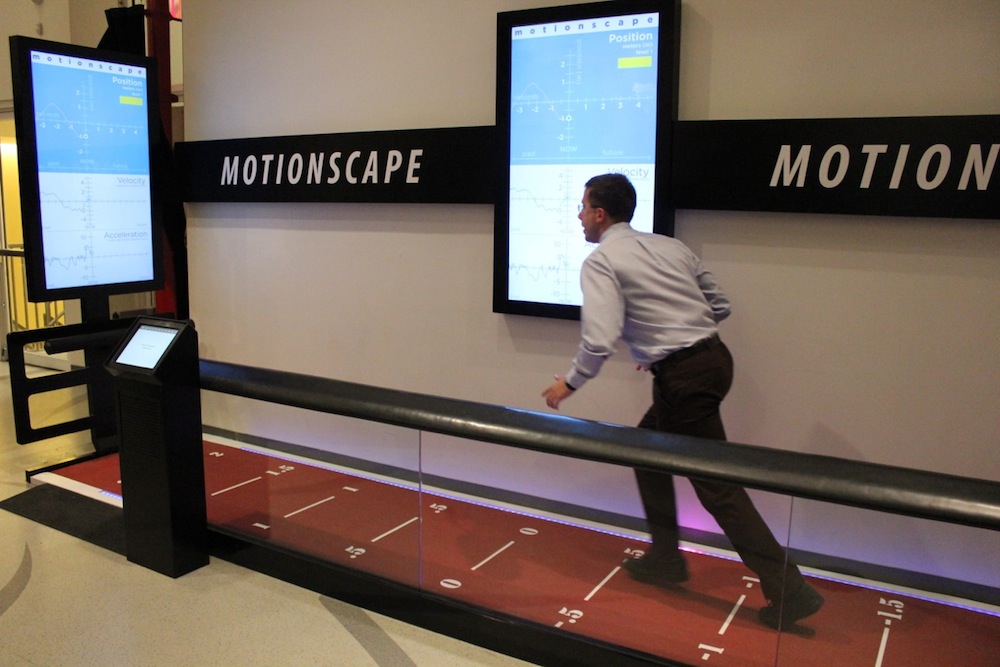Calculus Is Fun! Math Exhibit Demos Principles of Motion

NEW YORK — Most people probably don't think of learning calculus as fun. But a new interactive exhibit here at the Museum of Math (MoMath) lets visitors learn about the principles of motion in an interactive way, by walking or running on a special motion-sensing track.
The "Motion Scape" exhibit, which opens to the public Saturday (April 19), aims to give people of all ages an intuitive understanding of a fundamental application of calculus: how position, velocity and acceleration relate to one another.
These principles of motion "lie at the heart of one of the biggest revolutions in mathematics of all time, the invention of calculus," said Glen Whitney, co-executive director of MoMath. "It's something we relate to very much," Whitney told Live Science. [Album: The World's Most Beautiful Equations]
Real-life calculus
In the 17th century, the English mathematician Isaac Newton and French mathematician Gottfried Leibniz independently invented calculus, the mathematical study of change. Calculus describes how the position, velocity (speed and direction) and acceleration of an object are related mathematically.
Velocity is defined as the rate of change of position, and acceleration as the rate of change of velocity. In calculus, an operation known as taking the derivative gives you velocity from position, and acceleration from velocity. The reverse operation, known as the integral, gives you velocity from acceleration and position from velocity.
In the exhibit, a volunteer stands on a numbered, 16-foot (5 meters) track in front of a computer monitor. Overhead, two Microsoft Kinect sensors track the person's motion, and the computer screen displays charts of the individual's position, velocity and acceleration.
Get the world’s most fascinating discoveries delivered straight to your inbox.
The volunteer plays a game with two stages. In the first, the position challenge, the volunteer must move forward or backward to hit position targets displayed on the screen. If the person hits enough targets, he or she advances to the second stage, the velocity challenge. Here, the individual must speed up or slow down to hit velocity targets on the screen. Players can choose one of three difficulty levels.
Intuitive math
In real life, "we all think we understand the relationship between position and velocity," Whitney said. But, "when you try to do the position and velocity challenges, some basic confusions come to light," he said.
For example, most people end up far forward on the track, because they confuse position with velocity. That's why drivers tailgate each other on the highway — because they think that traveling as close as possible to the person in front will get them to their destination faster, Whitney said.
The exhibit also has a free-play mode, which allows people to explore how their position, velocity and acceleration change as they move.
Whitney said he expects the exhibit will be popular for all ages, from 6- and 7-year-olds to adults. "I think it's going to get a little rambunctious, but that's okay — math should be rambunctious," he said.
The exhibit is geared especially toward people who haven't taken calculus, to give them an intuition for the subject.
"In math, it is often taught that symbolism should come first and intuition second," Whitney said. "It shouldn't be that way. Real mathematics is intuition first, and then you capture intuition with symbols and equations and calculations."
Editor's Note: This article was updated at 3:43 p.m. April 25, to make minor changes to a quote by Glen Whitney.
Follow Tanya Lewis on Twitter and Google+. Follow us @livescience, Facebook & Google+. Original article on Live Science.



